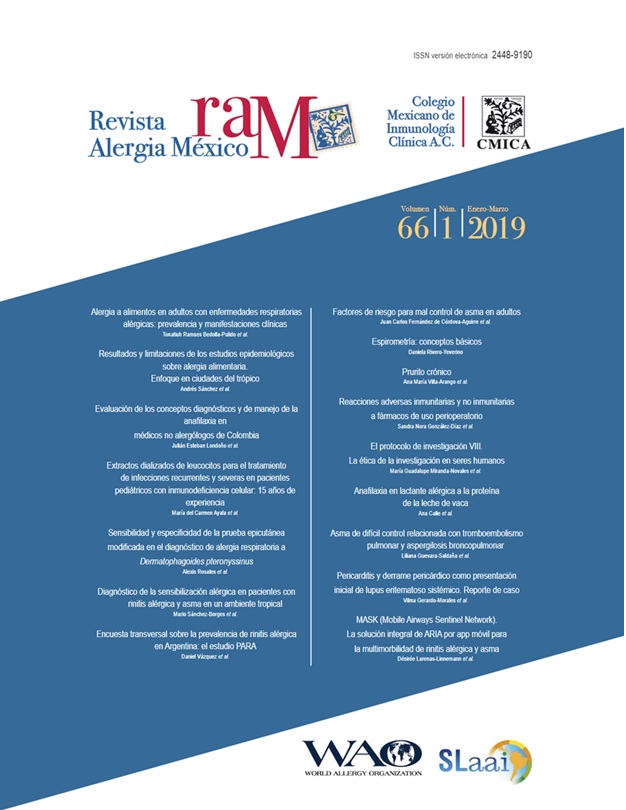Abstract
Background: Food allergy is considered a typical problem in the pediatric population, however, cases occur in adults more frequently.
Objective: To determine the prevalence of food allergy in patients with allergic rhinitis and asthma; as well as the foods and symptoms most related to said problem.
Methods: Through a cross-sectional study, the information of 257 adults with asthma or allergic rhinitis was analyzed. The information related to food allergy was obtained through a standardized interview; the confidence intervals (CI) were calculated for 95% proportions.
Results: The prevalence of food allergy was 17.5% (95% CI = 13.3% to 22.6%). The main foods that caused symptoms were soy, shrimp, almonds, avocado and peanuts. The majority of patients who were allergic to a single food were 35.6%, two foods were 17.8% and three foods were 17.8%. The most frequent affections of food allergy were oral (62.2%): itching of the pharynx, tongue and palate; respiratory (26.7%), dyspnea and sneezing; and skin (26.7%), itching and hives.
Conclusions: Food allergy in adults with asthma or allergic rhinitis is a common problem. Oral symptoms are the main ailments in this type of patients and are mainly caused by soy.
References
Kumar R, Kumari D, Srivastava P, Khare V, Fakhr H, Arora N, et al. Identification of IgE-mediated food allergy and allergens in older children and adults with asthma and allergic rhinitis. Indian J Chest Dis Allied Sci. 2010;52(4):217-224.
Rentzos G, Johanson L, Sjölander S, Telemo E, Ekerljung L. Self-reported adverse reactions and IgE sensitization to common foods in adults with asthma. Clin Transl Allergy. 2015;5:25. DOI: 10.1186/s13601-015-0067-6
Inam M, Shafique RH, Roohi N, Irfan M, Abbas S, Ismail M. Prevalence of sensitization to food allergens and challenge proven food allergy in patients visiting allergy centers in Rawalpindi and Islamabad, Pakistan. Springerplus. 2016;5(1):1330. DOI: 10.1186/s40064-016-2980-0
Burney PG, Potts J, Kummeling I, Mills EN, Clausen M, Dubakiene R, et al. The prevalence and distribution of food sensitization in European adults. Allergy. 2014;69(3):365-371. DOI: 10.1111/all.12341
Valle-Rodríguez I, Huerta-López JG, Huerta-Hernández RE. Alergia a alimentos. Alerg Asma Inmunol Pediatr. 2017;26(1):5-15. Disponible en: http://www.medigraphic.com/pdfs/alergia/al-2017/al171b.pdf
Waserman S, Watson W. Food allergy. Allergy Asthma Clin Immunol. 2011;7(Suppl 1):S7. DOI: 10.1186/1710-1492-7-S1-S7
Ramesh M, Lieberman JA. Adult-onset food allergies. Ann Allergy Asthma Immunol. 2017;119(2):111-119. DOI: 10.1016/j.anai.2017.05.014
James JM. Respiratory manifestations of food allergy. Pediatrics. 2003;111 (6 Pt 3):1625-1630. Disponible en: https://pediatrics.aappublications.org/content/111/Supplement_3/1625.long
Pénard-Morand C, Raherison C, Kopferschmitt C, Caillaud D, Lavaud F, Charpin D, et al. Prevalence of food allergy and its relationship to asthma and allergic rhinitis in schoolchildren. Allergy. 2005;60(9):1165-1171. DOI: 10.1111/j.1398-9995.2005.00860.x
Patelis A, Alving K, Middelveld R, James A, Ono J, Ohta S, et al. IgE sensitization to food allergens and airborne allergens in relation to biomarkers of type 2 inflammation in asthma. Clin Exp Allergy. 2018;48(9):1147-1154. DOI: 10.1111/cea.13165.
Silva LA, Silva AF, Ribeiro ÂC, Silva AO, Vieira FA, Segundo GR, et al. Adult food allergy prevalence: reducing questionnaire bias. Int Arch Allergy Immunol. 2016;171(3-4):261-264. DOI: 10.1159/000453036
Lee SH, Ban GY, Jeong K, Shin YS, Park HS, Lee S, et al. A retrospective study of Korean adults with food allergy: differences in phenotypes and causes. Allergy Asthma Immunol Res. 2017;9(6):534-539.
Bedolla-Barajas M, Bedolla-Pulido TR, Camacho-Peña AS, González-García E, Morales-Romero J. Food hypersensitivity in Mexican adults at 18 to 50 years of age: a questionnaire survey. Allergy Asthma Immunol Res. 2014;6(6):511-516. DOI: 10.4168/aair.2014.6.6.511
Van Kampen V, De Blay F, Folletti I, Kobierski P, Moscato G, Olivieri M, et al. EAACI position paper: skin prick testing in the diagnosis of occupational type I allergies. Allergy. 2013;68(5):580-584. DOI: 10.1111/all.12120
Sicherer SH, Muñoz-Furlong A, Godbold JH, Sampson HA. US prevalence of self-reported peanut, tree nut, and sesame allergy: 11-year follow-up. J Allergy Clin Immunol. 2010;125(6):1322-1326. DOI: 10.1016/j.jaci.2010.03.029
Larenas-Linnemann D, Salas-Hernández J, Vázquez-García JC, et al. Guía mexicana del asma 2017: GUIMA 2017. Rev Alerg Mex. 2017;64(Supl 1):s11-s128. Disponible en: http://revistaalergia.mx/ojs/index.php/ram/article/view/272/406
Brożek JL, Bousquet J, Agache I, Agarwal A, Bachert C, Bosnic-Anticevich S, et al. Allergic RHINITIS and its Impact on Asthma (ARIA) guidelines-2016 revision. J Allergy ClinImmunol. 2017;140(4):950-958. DOI: 10.1016/j.jaci.2017.03.050
Osterballe M, Mortz CG, Hansen TK, Andersen KE, Bindslev-Jensen C. The prevalence of food hypersensitivity in young adults. Pediatr Allergy Immunol. 2009;20(7):686-692. DOI: 10.1111/j.1399-3038.2008.00842.x

This work is licensed under a Creative Commons Attribution-NonCommercial 4.0 International License.
Copyright (c) 2019 Revista Alergia México

